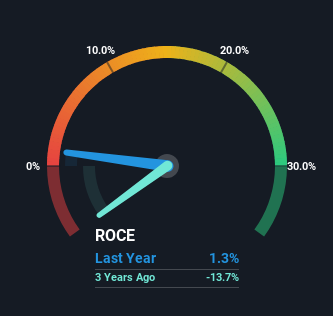- Hong Kong
- /
- Construction
- /
- SEHK:1630
Kin Shing Holdings (HKG:1630) Will Be Hoping To Turn Its Returns On Capital Around

If we're looking to avoid a business that is in decline, what are the trends that can warn us ahead of time? More often than not, we'll see a declining return on capital employed (ROCE) and a declining amount of capital employed. This indicates the company is producing less profit from its investments and its total assets are decreasing. So after we looked into Kin Shing Holdings (HKG:1630), the trends above didn't look too great.
Understanding Return On Capital Employed (ROCE)
For those who don't know, ROCE is a measure of a company's yearly pre-tax profit (its return), relative to the capital employed in the business. Analysts use this formula to calculate it for Kin Shing Holdings:
Return on Capital Employed = Earnings Before Interest and Tax (EBIT) ÷ (Total Assets - Current Liabilities)
0.013 = HK$2.0m ÷ (HK$491m - HK$331m) (Based on the trailing twelve months to September 2023).
Thus, Kin Shing Holdings has an ROCE of 1.3%. Ultimately, that's a low return and it under-performs the Construction industry average of 8.3%.
Check out our latest analysis for Kin Shing Holdings

Historical performance is a great place to start when researching a stock so above you can see the gauge for Kin Shing Holdings' ROCE against it's prior returns. If you want to delve into the historical earnings, revenue and cash flow of Kin Shing Holdings, check out these free graphs here.
How Are Returns Trending?
There is reason to be cautious about Kin Shing Holdings, given the returns are trending downwards. About five years ago, returns on capital were 14%, however they're now substantially lower than that as we saw above. And on the capital employed front, the business is utilizing roughly the same amount of capital as it was back then. This combination can be indicative of a mature business that still has areas to deploy capital, but the returns received aren't as high due potentially to new competition or smaller margins. So because these trends aren't typically conducive to creating a multi-bagger, we wouldn't hold our breath on Kin Shing Holdings becoming one if things continue as they have.
Another thing to note, Kin Shing Holdings has a high ratio of current liabilities to total assets of 67%. This effectively means that suppliers (or short-term creditors) are funding a large portion of the business, so just be aware that this can introduce some elements of risk. While it's not necessarily a bad thing, it can be beneficial if this ratio is lower.
Our Take On Kin Shing Holdings' ROCE
In the end, the trend of lower returns on the same amount of capital isn't typically an indication that we're looking at a growth stock. We expect this has contributed to the stock plummeting 86% during the last five years. That being the case, unless the underlying trends revert to a more positive trajectory, we'd consider looking elsewhere.
Kin Shing Holdings does come with some risks though, we found 3 warning signs in our investment analysis, and 1 of those is concerning...
While Kin Shing Holdings may not currently earn the highest returns, we've compiled a list of companies that currently earn more than 25% return on equity. Check out this free list here.
Valuation is complex, but we're here to simplify it.
Discover if Kin Shing Holdings might be undervalued or overvalued with our detailed analysis, featuring fair value estimates, potential risks, dividends, insider trades, and its financial condition.
Access Free AnalysisHave feedback on this article? Concerned about the content? Get in touch with us directly. Alternatively, email editorial-team (at) simplywallst.com.
This article by Simply Wall St is general in nature. We provide commentary based on historical data and analyst forecasts only using an unbiased methodology and our articles are not intended to be financial advice. It does not constitute a recommendation to buy or sell any stock, and does not take account of your objectives, or your financial situation. We aim to bring you long-term focused analysis driven by fundamental data. Note that our analysis may not factor in the latest price-sensitive company announcements or qualitative material. Simply Wall St has no position in any stocks mentioned.
About SEHK:1630
Kin Shing Holdings
An investment holding company, engages in erecting formworks for construction works in private residential and commercial buildings in Hong Kong.
Mediocre balance sheet and slightly overvalued.
Market Insights
Community Narratives



